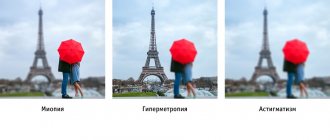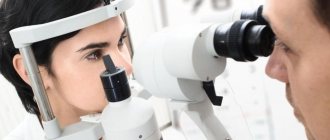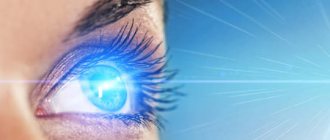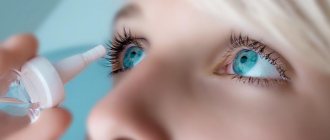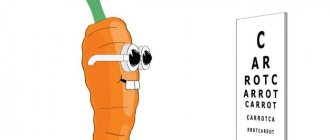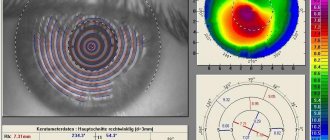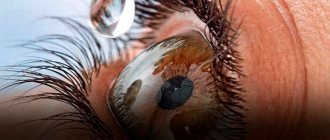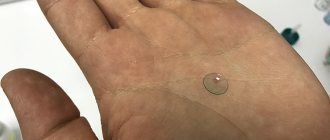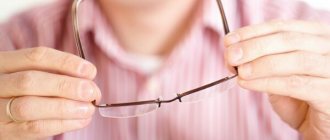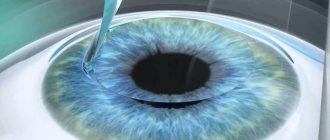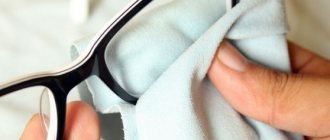Preschool children may experience various visual impairments. The difficulty of timely detection is that the child does not immediately notice the onset of ophthalmological problems, and parents can guess about it only by indirect signs. When eye problems are detected, vision correction and treatment in children is carried out in different ways.
Let's look at the methods used to restore and correct children's vision and give the cost of each method if the treatment was carried out in Moscow (it will be cheaper in other regions).
What are the symptoms for which it is worth starting treatment for myopia in a child?
The first and most important symptom for which it is worth talking about the need to treat myopia is deterioration of vision, when the child has difficulty seeing objects distant from him. But if teenagers have an understanding of what it is to “see well” and what it is to “see poorly,” then it is more difficult with young children. A preschooler is unlikely to complain to you that he sees poorly.
Therefore, it is worth paying attention to indirect symptoms at any age. Contact a specialist if you notice that your child:
- blinks frequently;
- gets tired quickly when reading a book;
- bends low over a book (sheet of paper, plasticine craft, etc.);
- often complains of headaches;
- rubs his eyes with his fists;
- squints his eyes, trying to see objects in the distance.
Myopia is affected by:
- hereditary factors. At risk are those children whose parents suffer from myopia;
- weak ability of the eye to accommodate;
- weak tissue of the sclera - the outer protective layer of the eye. As a result, under the influence of intraocular pressure, the eye stretches;
- high visual load - leads to overstrain of the eye muscles;
- general weakness of the body or birth injuries.
The progression of myopia is most often observed during school age.
Schoolchildren's vision should be checked annually; they can be classified as at risk for myopia. Be sure to show your child to a specialist. Often, formal checks at a school or clinic do not reveal an incipient eye disease.
When is amblyopia treatment required?
In most cases, amblyopia is a congenital disorder. Therefore, parents cannot always guess that their child needs treatment: the baby does not understand that the picture he sees is imperfect. Moreover, one eye works perfectly. The disease is almost impossible to determine on your own. You can guess about its existence when it has already developed and the child experiences the following symptoms:
- loss of orientation in unusual conditions and new places;
- impaired coordination of movements - the child acts clumsily and sloppily;
- deviation of one eye when reading and watching cartoons;
- a child closing one eye during increased visual load;
- increased fatigue.
To look at an object that interests him, a child with amblyopia will need to turn or tilt his head. Unfortunately, parents do not always understand that their child requires treatment. They often mistake the manifestations of the disease for ordinary childhood clumsiness.
How are children diagnosed?
Starting from birth, it is necessary to monitor your child's vision. At a young age, he is not yet able to name letters and objects according to the vision test table, but special devices used by the Center’s specialists will help to easily identify all vision problems in children.
Only a comprehensive examination by an experienced ophthalmologist will allow you to identify pathology at the earliest stage of development and take the necessary measures.
Many different methods are used to diagnose and treat myopia. They are selected depending on the age of the patient. Thus, methods that are effective for detecting ophthalmological diseases in adolescents are unacceptable for infants. Doctors at our clinic use various types of diagnostics.
All types of vision diagnostics in children with myopia at the Center for Vision Restoration:
Visual inspection. Extremely important, especially in children under three years of age. An experienced pediatric ophthalmologist will examine the position and shape of the eyeballs and assess whether the baby is able to fix his gaze on objects at different distances.
Biomicroscopy. Using an ophthalmological microscope (slit lamp), the specialist will see the condition of all structures of the eye: assess the condition of the fundus, lens, and cornea.
Direct ophthalmoscopy. With sixteen-fold magnification, the doctor examines the condition of the retina of a small patient’s eye and the safety of the optic nerve.
Skiascopy. Using a special skiascopic mirror, the ophthalmologist directs a beam of light into the eye and moves it, observing the reflection in the fundus. This method allows you to identify a patient’s refractive error and determine its degree.
Computer autorefractometry. While the child is looking at a beautiful photograph of a balloon or a house, the device automatically measures the degree of refraction (myopia, farsightedness) and the presence of astigmatism.
Ultrasound scanning of the eye. This is an extremely important study in children with myopia. It allows you to determine the length of the eye (anterior-posterior axis of the eye, APO) - the degree and type of myopia depends on it. An ultrasound examination with a special sensor also allows you to identify dangerous abnormalities in the eye, such as retinal detachments, scars, and foreign objects.
Determination of visual acuity using a diagnostic combine.
PlusOptix - this unique device will determine the refraction of a child's eye from a distance, while you simply hold him in your arms.
Vision testing should be carried out from birth. Our clinic uses modern equipment, with which we can detect abnormalities in the functioning of the eyes even in the youngest patients. Remember: timely diagnosis is the basis for effective treatment of myopia!
Advantages of hardware treatment:
- No surgical intervention
- Painless
- Possibility of repeated and repeated courses of treatment
- Availability
- Easy course correction if necessary
- Easy compatibility with other treatment methods
- The ability to cure and/or prevent many ophthalmic diseases.
Hardware treatment saves vision under heavy loads from working on a computer and, according to reviews from numerous patients of our clinic, it actually returns lost visual acuity without lenses, glasses and operations. The main thing is to start it on time. Therefore, at the first signs of discomfort in the eyes and decreased vision, contact a specialist. We use only advanced equipment and select a “recipe” for hardware treatment individually for each patient. Questions and answers on hardware treatment
Spasm of accommodation, or false myopia: causes.
From eye strain, a child may experience a spasm of accommodation, or false myopia, which based on its symptoms is very easy to confuse with true myopia. The patient may see distant objects as blurry, complain of rapid eye fatigue and headaches.
Excessive eye strain can occur when working at close range for a long time, reading in poor lighting, watching television for a long time, working at a computer, improper daily routine, poor posture, and constant emotional stress.
Accommodation spasm is a reversible process that can be eliminated with timely treatment. Otherwise, it can lead to true myopia.
In the children's department of our Center, you will be prescribed a set of activities aimed at relaxing spasmodic eye muscles, and the child will return to good clear vision.
Devices and apparatus
In their clinical practice, domestic ophthalmologists have been successfully using the LAST-01 device for a long time. It consists of a control unit, a flexible light guide and a manipulator, to which laser radiation is supplied. The effect of its laser therapy and laser stimulation is ensured by low-intensity radiation from a pulsed semiconductor laser with the possibility of defocusing with a red spot and the formation of a certain microstructure (speckle) from alternating light and dark spots (speckle fields).
Features of the treatment of myopia in children
Treatment of myopia in adolescents and preschoolers is not aimed at eliminating myopia or reducing its degree, but at stopping its progression. Another task of the doctor is timely prevention of complications.
If a child’s myopia progresses by no more than 0.5 diopters per year, it is considered to be within normal limits, in which case conservative treatment is carried out. Recommendations include wearing glasses, periodic eye rest, visual exercises, walking, proper nutrition and visual hygiene.
Indications and contraindications for laser stimulation
| Indications | Contraindications |
|
|
Treatment of myopia in children at the Center for Vision Restoration
Our team consists of ophthalmologists with many years of experience. Treatment programs are selected individually, taking into account the patient’s age, characteristics of his disease and psycho-emotional status.
The Center for Vision Restoration provides comprehensive treatment for progressive childhood myopia. We use medicinal, optical, physiotherapeutic and functional effects. All techniques are aimed at stabilizing the elongation of the eyeball and stopping the further progression of myopia.
For treatment we use the most modern equipment and techniques:
- ophthalmic simulator "Visotronic". Stimulates the eye muscles, relieves tension, improves blood flow in the vessels of the eye. Accelerates recovery and adaptive processes;
- device "Rucheek". Trains the accommodation mechanism - the gaze focuses on images that appear at different distances from the eye;
- photomagnetic stimulation. The color magnetic stimulator simultaneously provides light and magnetic stimulation of vision;
- vacuum massage (Sidorenko glasses). The therapeutic effect is achieved due to pressure changes. Blood circulation and metabolic processes improve, the work of the muscles responsible for accommodation is stimulated;
- computer programs. Special programs - “Cross”, “Blade”, Relax and others - combine visual stimulation and stimulation of the centers in the cerebral cortex responsible for the ability to see. The technique is used as part of complex therapy;
- electrical stimulation. Exposure to dosed low-intensity electric current increases impulse conductivity of the optic nerves.
- medicinal electrophoresis is a physiotherapeutic method of electrotherapy, which consists of influencing the body with low-power direct current and medications;
- accommodation training using the Avetisov-Matz method;
- drug therapy;
- the Amblyokor device - many of our little patients really liked it, because during the treatment process they watch cartoons. But as soon as the child begins to look incorrectly, the picture disappears and appears again only at the moment of “correct” vision. In this way, the correct functioning of the entire visual analyzer is stimulated.
Contact the Vision Restoration Center for myopia treatment. Take care of your child's visual hygiene: following simple rules will help him maintain good vision. Dose the child’s visual loads, be sure to alternate them with moments of rest, preferably in the fresh air. Do not read while lying down or while eating. Be sure to work in good lighting. The less often a child watches TV, plays on a tablet or phone, or works on a computer, the better for his eyes. The optimal time for such entertainment is 30–40 minutes a day.
Take care of your children's eyesight!
Nearsightedness or myopia is a disease in which children have difficulty distinguishing objects that are in the distance.
The growth of the eyeball continues until approximately 16–18 years of age. The accommodative muscles of the eyes are not yet sufficiently developed at an early age, so in the world of computers, mobile phones and tablets, the risk of developing myopia is quite high. This disease requires immediate treatment. The sooner help is provided, the less likely there is to lose vision and the greater the chance of avoiding problems in adulthood.
Prices for myopia treatment
Myopia Treatment Price
Myopia (session) RUB 3,000.
Myopia (course of treatment) RUB 30,000.
Entire price list
Make an appointment
According to statistics, every third student in high school is diagnosed with myopia.
Unfortunately, myopia is not only a vision defect that can be corrected with glasses. Due to the fact that with myopia, the eyeball is enlarged, the internal structures of the eye are stretched, the retina suffers, and degenerative changes appear in the fundus of the eye, which without adequate treatment can lead to irreversible loss of vision.
Do not delay treatment: if the first symptoms of the disease occur, contact an ophthalmologist. In childhood, you can cope with the disease without resorting to surgery.
Conventionally, there are three degrees of myopia: low degree (up to –3 diopters), moderate degree (from –3 to –6 diopters) and high (over 6 diopters). Myopia can be acquired, congenital or hereditary.
Myopia is also called long eye disease. An increase in eye length by 1 mm compared to the norm results in a decrease in vision by approximately 3 diopters. And in childhood, the eye grows along with the rest of the body.
Computer methods of pleoptics
The pleoptic technique is carried out using computer technology. For this purpose, various programs for adults are used, and special games have been developed for children. The system contains types of games intended for children, namely:
- "Tiger" or "Pursuit". While looking at the monitor, stimulation of the retina is caused by objects becoming smaller and larger. During therapy, an increase in visual acuity and normalization of retinal function are observed.
- "Cross" The playing field is presented in the form of a chessboard. During therapy, cells change their size characteristics. At some stages of the game, color stimulation also occurs, since the game changes the hue on the playing field.
- "Spider." The screen displays radial and spiral types of gratings. Dynamic animations help activate accommodation and central vision.
- "Relief". The game is used for pediatric patients to eliminate amblyopia with correct fixation. During the procedure, various figures with differences in shadows and light are presented on the monitor.
- "Contour". The goal of the game is to train the muscle fibers of the organ of vision. The patient is shown figures that he must draw with his lazy eye.
- "Flower". In the center of the monitor there is a flower with various images on its petals. There is a picture in the middle of the flower. The patient's goal is to point out identical images on the petals and in the middle of the flower.
- "Amblyocor". The program is designed to eliminate the complicated course of amblyopia and congenital forms of the disease. After undergoing therapy, the development of reflex mechanisms of the brain is observed, which makes it possible to restore the distorted image of the retina of the visual apparatus. Ophthalmologists recommend treatment for patients who have exceeded 4 years of age.
Computer-assisted retinal stimulation techniques facilitate the treatment of amblyopia in young children. During the procedure, there is no stress for the child, since stimulation is presented in the form of a game.
What are the symptoms for which it is worth starting treatment for myopia in a child?
The first and most important symptom for which it is worth talking about the need to treat myopia is deterioration of vision, when the child has difficulty seeing objects distant from him. But if teenagers have an understanding of what it is to “see well” and what it is to “see poorly,” then it is more difficult with young children. A preschooler is unlikely to complain to you that he sees poorly.
Therefore, it is worth paying attention to indirect symptoms at any age. Contact a specialist if you notice that your child:
- blinks frequently;
- gets tired quickly when reading a book;
- bends low over a book (sheet of paper, plasticine craft, etc.);
- often complains of headaches;
- rubs his eyes with his fists;
- squints his eyes, trying to see objects in the distance.
Myopia is affected by:
- hereditary factors. At risk are those children whose parents suffer from myopia;
- weak ability of the eye to accommodate;
- weak tissue of the sclera - the outer protective layer of the eye. As a result, under the influence of intraocular pressure, the eye stretches;
- high visual load - leads to overstrain of the eye muscles;
- general weakness of the body or birth injuries.
The progression of myopia is most often observed during school age.
Schoolchildren's vision should be checked annually; they can be classified as at risk for myopia. Be sure to show your child to a specialist. Often, formal checks at a school or clinic do not reveal an incipient eye disease.
How does electrical stimulation occur?
During the procedure, a special device is used - a microprocessor ophthalmic electrical stimulator.
Electrostimulators "Phosphen"
Once the characteristics of each patient that the electrical stimulator must cope with have been determined, one of its sensors needs to be attached to the patient's arm, and the other to the eyelid.
The entire stimulation process takes no more than 15 minutes. The patient does not experience pain or discomfort; he can only observe the barely flickering light. The procedure must be carried out every day, for each eye separately. The electrical stimulators most often used by doctors are Phosphen and Phosphen-M.
Electrostimulators "Phosphen" and "Phosphen M"
How are children diagnosed?
Starting from birth, it is necessary to monitor your child's vision. At a young age, he is not yet able to name letters and objects according to the vision test table, but special devices used by the Center’s specialists will help to easily identify all vision problems in children.
Only a comprehensive examination by an experienced ophthalmologist will allow you to identify pathology at the earliest stage of development and take the necessary measures.
Many different methods are used to diagnose and treat myopia. They are selected depending on the age of the patient. Thus, methods that are effective for detecting ophthalmological diseases in adolescents are unacceptable for infants. Doctors at our clinic use various types of diagnostics.
All types of vision diagnostics in children with myopia at the Center for Vision Restoration:
Visual inspection. Extremely important, especially in children under three years of age. An experienced pediatric ophthalmologist will examine the position and shape of the eyeballs and assess whether the baby is able to fix his gaze on objects at different distances.
Biomicroscopy. Using an ophthalmological microscope (slit lamp), the specialist will see the condition of all structures of the eye: assess the condition of the fundus, lens, and cornea.
Direct ophthalmoscopy. With sixteen-fold magnification, the doctor examines the condition of the retina of a small patient’s eye and the safety of the optic nerve.
Skiascopy. Using a special skiascopic mirror, the ophthalmologist directs a beam of light into the eye and moves it, observing the reflection in the fundus. This method allows you to identify a patient’s refractive error and determine its degree.
Computer autorefractometry. While the child is looking at a beautiful photograph of a balloon or a house, the device automatically measures the degree of refraction (myopia, farsightedness) and the presence of astigmatism.
Ultrasound scanning of the eye. This is an extremely important study in children with myopia. It allows you to determine the length of the eye (anterior-posterior axis of the eye, APO) - the degree and type of myopia depends on it. An ultrasound examination with a special sensor also allows you to identify dangerous abnormalities in the eye, such as retinal detachments, scars, and foreign objects.
Determination of visual acuity using a diagnostic combine.
PlusOptix - this unique device will determine the refraction of a child's eye from a distance, while you simply hold him in your arms.
Vision testing should be carried out from birth. Our clinic uses modern equipment, with which we can detect abnormalities in the functioning of the eyes even in the youngest patients. Remember: timely diagnosis is the basis for effective treatment of myopia!
Diagnosis of amblyopia
The presence of amblyopia can be detected using diagnostic procedures using modern equipment. Before treatment, the doctor will determine visual acuity using a table and prescribe the following tests:
- refractometry before and after pupil dilation;
- skiascopy;
- direct and reverse ophthalmoscopy with examination of the fundus.
When treating amblyopia, it is important to exclude other causes of vision loss. For this purpose the following are assigned:
- optical coherence tomography of the retina;
- diagnosis of problems in the oculomotor system (will help determine microsquint).
Spasm of accommodation, or false myopia: causes.
From eye strain, a child may experience a spasm of accommodation, or false myopia, which based on its symptoms is very easy to confuse with true myopia. The patient may see distant objects as blurry, complain of rapid eye fatigue and headaches.
Excessive eye strain can occur when working at close range for a long time, reading in poor lighting, watching television for a long time, working at a computer, improper daily routine, poor posture, and constant emotional stress.
Accommodation spasm is a reversible process that can be eliminated with timely treatment. Otherwise, it can lead to true myopia.
In the children's department of our Center, you will be prescribed a set of activities aimed at relaxing spasmodic eye muscles, and the child will return to good clear vision.
Normal duration of treatment course
The course of electrical stimulation takes from 1 to 2 weeks. This period is due to the need for the formation of a certain state of inertia in the brain - stable, capable, without the help of a stimulant, of maintaining the vital activity of the cells of the nervous tissue that take part in the direction, transmission and perception of impulses sent by the organ of vision.
The course of treatment usually lasts from one to two weeks
Features of the treatment of myopia in children
Treatment of myopia in adolescents and preschoolers is not aimed at eliminating myopia or reducing its degree, but at stopping its progression. Another task of the doctor is timely prevention of complications.
If a child’s myopia progresses by no more than 0.5 diopters per year, it is considered to be within normal limits, in which case conservative treatment is carried out. Recommendations include wearing glasses, periodic eye rest, visual exercises, walking, proper nutrition and visual hygiene.
Preparation and implementation of laser stimulation
The procedure does not require any preparatory measures from the patient; it is enough for him to visit the doctor’s office in a timely manner. During the process, he takes a sitting position, closing one eye. The second one looks into the lens of the device that generates and delivers laser pulses.
The process does not use eye drops or any other pharmacological drugs. The absence of discomfort and contact with the ocular surface eliminates the use of anesthesia. The course of treatment is considered successful if the ophthalmologist notes:
- increased visual acuity;
- positive dynamics in color perception;
- increased blood flow in the vessels;
- reduction of pathological changes in the iris.
You can undergo a course of treatment and prevention of various eye diseases at the Sfera ophthalmology clinic. We employ leading domestic specialists who have a unique base of diagnostic and operational equipment. Treatment is carried out in accordance with international standards. Call: +7 (495) 139-09-81!
Visotronic
Visotronic" is an ophthalmic myotrainer-relaxer designed to treat and prevent the development of chronic visual fatigue syndrome, computer visual syndrome, acquired myopia in children, accommodation spasm in people exposed to intense visual stress (reading, writing, working with a computer). In addition, the device is indicated for patients engaged in certain types of work that require high eye accuracy and for athletes in shooting sports.
More details
Methods for treating eye diseases
The advantage that children have over adults is that their growing bodies are able to restore vision much faster, with proper treatment. Treatment methods can be divided into two groups:
- surgery;
- therapeutic treatment.
To treat childhood vision pathologies, they most often resort to therapeutic treatment so as not to harm the growing body through surgical intervention. Therapeutic treatment can completely restore vision or stop the active progression of the disease.
Therapeutic treatment methods include the following types of hardware treatment:
- magnetic therapy;
- electrical stimulation;
- laser therapy;
- ultrasound therapy;
- photostimulation;
- devices for relaxing the eye muscles - ophthalmic relaxants;
- color therapy;
- ophthalmochomotherapy;
- computer treatment;
- medoptics (device "Rucheek");
- massage glasses.
